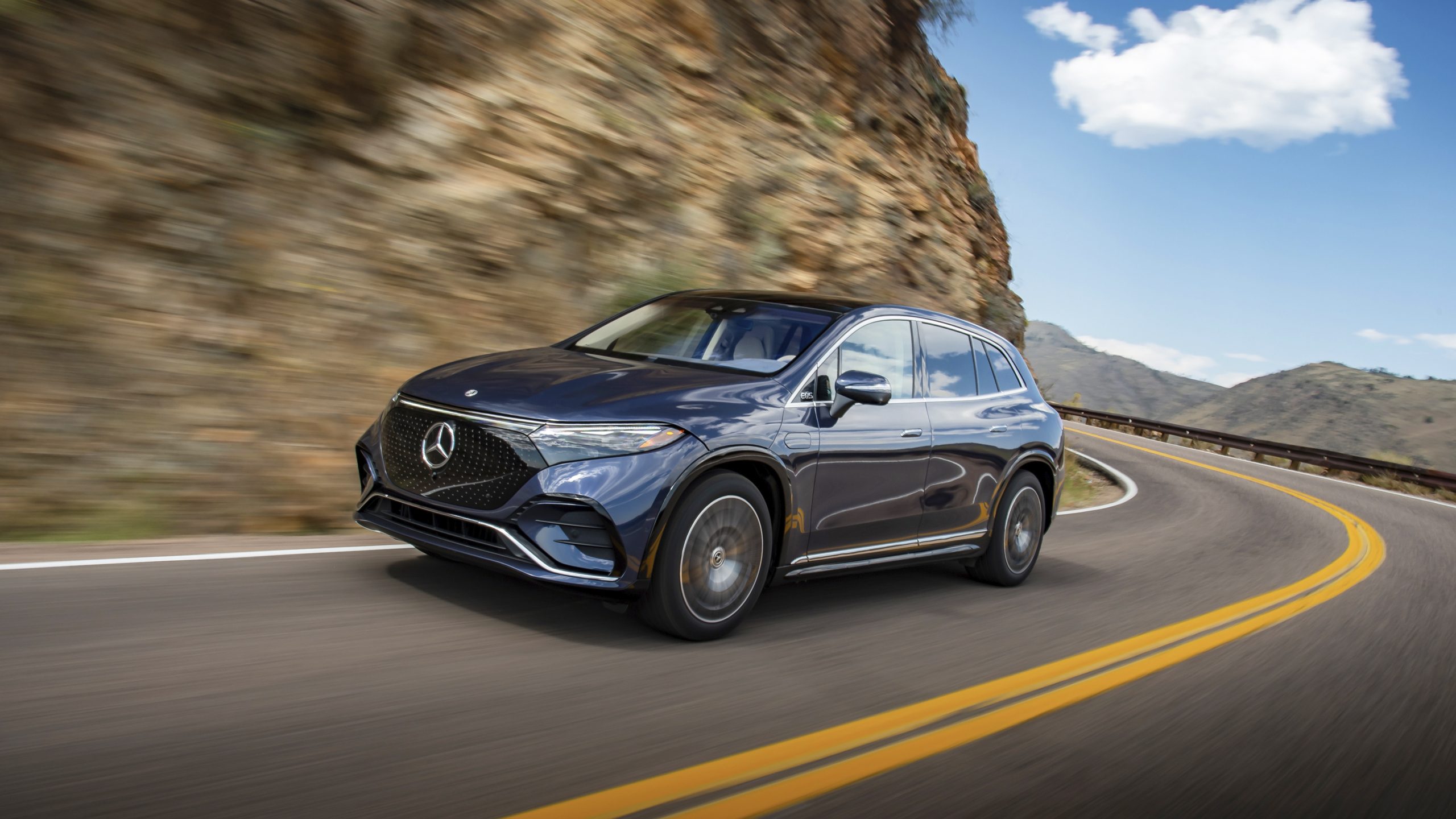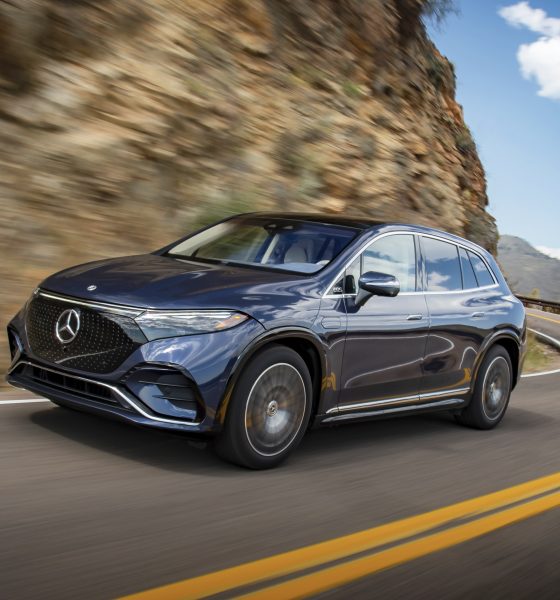

News
Mercedes announces Q4 sales growth, led by ‘electric product offensive’
Mercedes has released its Q4 and 2022 sales report, and electric vehicles led the company in growth.
Mercedes has been increasing its electric offerings significantly faster than traditional rivals. The company now offers as many as eight electric models in certain markets, multiples of the number of offerings from BMW, Porsche, and Audi, and even outshines most non-premium brands globally. Via this aggressive electrification, the brand reported a strong end of the year and a clear path forward to investors.
According to Mercedes’ press release, the company sold a total of 2.04 million vehicles globally (slightly less than the premium market leader, BMW), with 350,949 units sold in the United States alone. Of that overall figure, Mercedes massively expanded EV sales by 124%, selling a total of 117,800 EVs globally and 12,421 of which were sold in the U.S.
Globally, while Q4 was an amazingly successful quarter for the company, increasing sales by 17%, Mercedes still finished off the year down by 1% compared to 2021.
Looking at more model-specific numbers, in the U.S., the Mercedes EQS SUV/sedan was the clear leader in terms of EV sales. 10,365 units made the company’s oldest Mercedes EV model a fantastic success, while its more recently released EQE and EQB siblings had 384 and 1672 sales, respectively.
“Strong year-end results and exponential volume growth of our EV portfolio are a testament to the strong demand for Mercedes-Benz EQ, luxury and commercial vehicles in the U.S. market,” said Dimitris Psillakis, President and CEO of Mercedes-Benz USA. “With a full lineup of five EQ models and a renewed focus on Top-End Vehicles, we will continue to advance our strategy and offer the most desirable luxury cars, SUVs, and commercial vehicles.”
Mercedes-Benz global CEO, Ola Källenius, had a similarly positive message for investors in the worldwide press release; “2022 marks another successful year in the transformation of Mercedes-Benz: We more than doubled our BEV sales, we demonstrated our high ambition in electric with the 1,200 km EQXX test drive, and we achieved a new record year for Mercedes-Maybach with sales up 37%,” said Mr. Källenius. “In 2023, we will continue our mission to offer the most desirable electric cars and further grow our BEV and Top-End sales.”
A successful sales quarter isn’t the only reason Mercedes has reason to be excited, either. Now that the company has announced its EV charging network in the United States and expanded its autonomous driving suite to North America, it leads traditional competitors in more than just BEV offerings. And with the German luxury giant’s recent announcements at CES regarding more upcoming software improvements, it doesn’t seem like it is laying off the gas.
For Mercedes, the goal remains clear, moving into an EV future, it must continue to electrify rapidly and focus on expanding EV production in the coming year(s) to compete with EV-only brands like Tesla. And while it is clear that the company is headed on the right path, it still has a long road ahead of it.
What do you think of the article? Do you have any comments, questions, or concerns? Shoot me an email at william@teslarati.com. You can also reach me on Twitter @WilliamWritin. If you have news tips, email us at tips@teslarati.com!

News
Tesla FSD fleet is nearing 7 billion total miles, including 2.5 billion city miles
As can be seen on Tesla’s official FSD webpage, vehicles equipped with the system have now navigated over 6.99 billion miles.

Tesla’s Full Self-Driving (Supervised) fleet is closing in on almost 7 billion total miles driven, as per data posted by the company on its official FSD webpage.
These figures hint at the massive scale of data fueling Tesla’s rapid FSD improvements, which have been quite notable as of late.
FSD mileage milestones
As can be seen on Tesla’s official FSD webpage, vehicles equipped with the system have now navigated over 6.99 billion miles. Tesla owner and avid FSD tester Whole Mars Catalog also shared a screenshot indicating that from the nearly 7 billion miles traveled by the FSD fleet, more than 2.5 billion miles were driven inside cities.
City miles are particularly valuable for complex urban scenarios like unprotected turns, pedestrian interactions, and traffic lights. This is also the difference-maker for FSD, as only complex solutions, such as Waymo’s self-driving taxis, operate similarly on inner-city streets. And even then, incidents such as the San Francisco blackouts have proven challenging for sensor-rich vehicles like Waymos.
Tesla’s data edge
Tesla has a number of advantages in the autonomous vehicle sector, one of which is the size of its fleet and the number of vehicles training FSD on real-world roads. Tesla’s nearly 7 billion FSD miles then allow the company to roll out updates that make its vehicles behave like they are being driven by experienced drivers, even if they are operating on their own.
So notable are Tesla’s improvements to FSD that NVIDIA Director of Robotics Jim Fan, after experiencing FSD v14, noted that the system is the first AI that passes what he described as a “Physical Turing Test.”
“Despite knowing exactly how robot learning works, I still find it magical watching the steering wheel turn by itself. First it feels surreal, next it becomes routine. Then, like the smartphone, taking it away actively hurts. This is how humanity gets rewired and glued to god-like technologies,” Fan wrote in a post on X.
News
Tesla starts showing how FSD will change lives in Europe
Local officials tested the system on narrow country roads and were impressed by FSD’s smooth, human-like driving, with some calling the service a game-changer for everyday life in areas that are far from urban centers.

Tesla has launched Europe’s first public shuttle service using Full Self-Driving (Supervised) in the rural Eifelkreis Bitburg-Prüm region of Germany, demonstrating how the technology can restore independence and mobility for people who struggle with limited transport options.
Local officials tested the system on narrow country roads and were impressed by FSD’s smooth, human-like driving, with some calling the service a game-changer for everyday life in areas that are far from urban centers.
Officials see real impact on rural residents
Arzfeld Mayor Johannes Kuhl and District Administrator Andreas Kruppert personally tested the Tesla shuttle service. This allowed them to see just how well FSD navigated winding lanes and rural roads confidently. Kruppert said, “Autonomous driving sounds like science fiction to many, but we simply see here that it works totally well in rural regions too.” Kuhl, for his part, also noted that FSD “feels like a very experienced driver.”
The pilot complements the area’s “Citizen Bus” program, which provides on-demand rides for elderly residents who can no longer drive themselves. Tesla Europe shared a video of a demonstration of the service, highlighting how FSD gives people their freedom back, even in places where public transport is not as prevalent.
What the Ministry for Economic Affairs and Transport says
Rhineland-Palatinate’s Minister Daniela Schmitt supported the project, praising the collaboration that made this “first of its kind in Europe” possible. As per the ministry, the rural rollout for the service shows FSD’s potential beyond major cities, and it delivers tangible benefits like grocery runs, doctor visits, and social connections for isolated residents.
“Reliable and flexible mobility is especially vital in rural areas. With the launch of a shuttle service using self-driving vehicles (FSD supervised) by Tesla in the Eifelkreis Bitburg-Prüm, an innovative pilot project is now getting underway that complements local community bus services. It is the first project of its kind in Europe.
“The result is a real gain for rural mobility: greater accessibility, more flexibility and tangible benefits for everyday life. A strong signal for innovation, cooperation and future-oriented mobility beyond urban centers,” the ministry wrote in a LinkedIn post.
News
Tesla China quietly posts Robotaxi-related job listing
Tesla China is currently seeking a Low Voltage Electrical Engineer to work on circuit board design for the company’s autonomous vehicles.

Tesla has posted a new job listing in Shanghai explicitly tied to its Robotaxi program, fueling speculation that the company is preparing to launch its dedicated autonomous ride-hailing service in China.
As noted in the listing, Tesla China is currently seeking a Low Voltage Electrical Engineer to work on circuit board design for the company’s autonomous vehicles.
Robotaxi-specific role
The listing, which was shared on social media platform X by industry watcher @tslaming, suggested that Tesla China is looking to fill the role urgently. The job listing itself specifically mentions that the person hired for the role will be working on the Low Voltage Hardware team, which would design the circuit boards that would serve as the nervous system of the Robotaxi.
Key tasks for the role, as indicated in the job listing, include collaboration with PCB layout, firmware, mechanical, program management, and validation teams, among other responsibilities. The role is based in Shanghai.
China Robotaxi launch
China represents a massive potential market for robotaxis, with its dense urban centers and supportive policies in select cities. Tesla has limited permission to roll out FSD in the country, though despite this, its vehicles have been hailed as among the best in the market when it comes to autonomous features. So far, at least, it appears that China supports Tesla’s FSD and Robotaxi rollout.
This was hinted at in November, when Tesla brought the Cybercab to the 8th China International Import Expo (CIIE) in Shanghai, marking the first time that the autonomous two-seater was brought to the Asia-Pacific region. The vehicle, despite not having a release date in China, received a significant amount of interest among the event’s attendees.








